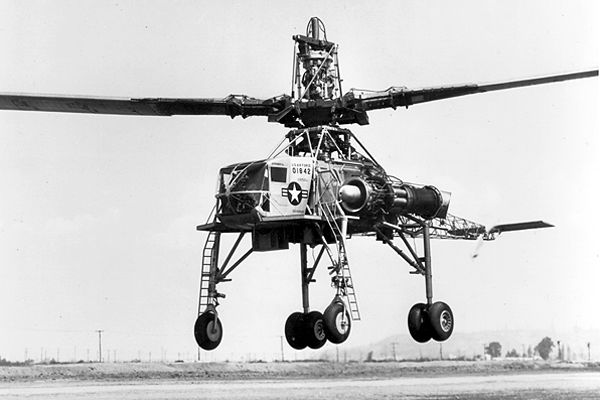| Picture |

|
| Manufacturer |
Hughes
|
| Type |
XH-17 Flying crane
|
| Introduced |
10/23/1952
|
| In production? |
No
|
| Units produced |
1
|
| Price US $ |
0.00
|
| Overall Length |
0 ft
|
| Length |
53.3 ft
|
| Height |
30.1 ft
|
| Width |
0 ft
|
| |
|
| |
|
| Description |
This gigantic helicopter was designed as a transport vessel for heavy military equipment like tanks and artillery. Its development was initiated by the US Army, and the Kellet Aircraft Corporation was chosen to develop this very heavy transport helicopter. Unfortunately, they were not able to finish it due to financial problems and therefore sold the design to the Hughes Tool Company in 1948.
The way the prototype was built is remarkable, with important parts (front and rear wheels, fuel tank, cockpit) literally taken from other airplanes (respectively the B-25 Mitchell, the C-54 Skymaster, the B-29 Superfortress, and the Waco CG-15). The tail rotor system was taken from a Sikorsky S-55 helicopter.
The first flight was in 1952 at Hughes Airport in Culver City, California. The Flying Crane, as the prototype was known, only flew for several hours over a period of approximately three years. Moreover, although it could lift very heavy objects as expected, the turbojet driven rotor system was very fuel inefficient and noisy. This resulted in an extremely poor maximum range of only 40 miles. The XH-17 still holds the record for flying with the largest rotor blades.
Another severe limitation of the prototype was the 10 hour fatigue life of the rotor blades. The stability of the machine was also poor.
Despite these problems, the US Air Force ordered a second prototype, the XH-28. However, the development was cancelled because of a lack of funding after the end of the Korean War.
The XH-17 was the first Hughes helicopter and was clearly not successful. Nevertheless, this didn't stop Hughes from entering the helicopter market. And, as it turned out, it did so with a lot more success.
|
| Advertisement |
|
| Design features |
- Turbojets fed with bleed air vented through the rotor blades
- Very tall, wheel based, landing gear
- Sikorsky S-55 tail rotor system
- Rotor angular velocity of 88 rpm
|
This gigantic helicopter was designed as a transport vessel for heavy military equipment like tanks and artillery. Its development was initiated by the US Army, and the Kellet Aircraft Corporation was chosen to develop this very heavy transport helicopter. Unfortunately, they were not able to finish it due to financial problems and therefore sold the design to the Hughes Tool Company in 1948.
The way the prototype was built is remarkable, with important parts (front and rear wheels, fuel tank, cockpit) literally taken from other airplanes (respectively the B-25 Mitchell, the C-54 Skymaster, the B-29 Superfortress, and the Waco CG-15). The tail rotor system was taken from a Sikorsky S-55 helicopter.
The first flight was in 1952 at Hughes Airport in Culver City, California. The Flying Crane, as the prototype was known, only flew for several hours over a period of approximately three years. Moreover, although it could lift very heavy objects as expected, the turbojet driven rotor system was very fuel inefficient and noisy. This resulted in an extremely poor maximum range of only 40 miles. The XH-17 still holds the record for flying with the largest rotor blades.
Another severe limitation of the prototype was the 10 hour fatigue life of the rotor blades. The stability of the machine was also poor.
Despite these problems, the US Air Force ordered a second prototype, the XH-28. However, the development was cancelled because of a lack of funding after the end of the Korean War.
The XH-17 was the first Hughes helicopter and was clearly not successful. Nevertheless, this didn't stop Hughes from entering the helicopter market. And, as it turned out, it did so with a lot more success.
|
|
- Advertisement -
|
Design features:
- Turbojets fed with bleed air vented through the rotor blades
- Very tall, wheel based, landing gear
- Sikorsky S-55 tail rotor system
- Rotor angular velocity of 88 rpm
|
| Persons |
3
|
| Max. Range |
40 mi
|
| Cruise Speed |
85 mph
|
| Max. Speed |
90 mph
|
| Max. rate of Climb |
1650 ft/min
|
| HOGE ceiling |
0 ft
|
| Service Ceiling |
13100 ft
|
| Gross Weight |
43500 lb
|
| Empty Weigt |
28563 lb
|
| Useful Load |
14937 lb
|
| Fuel Capacity |
0 gallons
|
| Number of Engines |
2
|
| Engine Type |
Turbojet
|
| Engine Code |
General Electric J35
|
| Horse Power |
|
| Rotorhead |
|
| Number of rotorblades |
2
|
| Rotor Diameter |
130 ft
|
| Number of tail rotorblades |
2
|
| Tailrotor Diameter |
8.2 ft
|
|